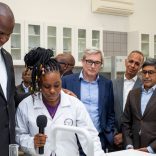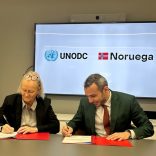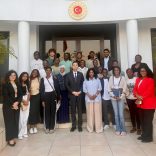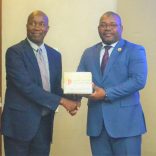Mozambique: Chapo praises the excellence of the Aga Khan Academy and advocates the expansion of the ...
Mozambique: 16-year-old student creates sensor to tackle robberies in her neighbourhood – Watch

Photo: Folha
Gisela Chimoio, a 16-year-old student at a secondary school in Beira city, central Mozambique, got tired of seeing robberies in her neighbours’ homes and created an electronic sensor that she will now install throughout the community.
“There have been many robberies. Thieves arrive at a residence, break down the door, steal goods from the house, without people noticing,” explained the Escola Secundária Mateus Sansão Mutemba student, inventor of the electronic sensor that detects suspicious movements in her community, the Manga neighbourhood in Beira city.
Dressed in her school uniform and flanked by the chemistry teacher responsible for science and technology at the school, Gisela says that developed the project to try to “minimise” the problem of robberies.
“It works with the presence of people which activates a bell that rings. The movement sensor is set up in the area that you want to protect,” she explained. “So, any movement that takes place in the area, the alarm bell will ring and then you can wake up. You can call the police or intervene and this theft never happens.”
The school management intends to support the production of more devices and also plans to register the electronic sensor created by the student, for the protection of intellectual property.
The proud Gisela says that it took two days to create that device, the most appreciated and requested at the District Science and Technology Fair recently held in the city, with projects by students from schools across the province of Sofala.
She admits that this is her first project to make it from paper to reality, but hopes to create similar ones in the near future, given the demand for this alarm sensor.
“At the district fair a lot of people praised it and asked to assemble it or buy it,” she said.
With the aim of fostering a taste for science, schools have selected children to develop projects in favour of the community, such as Gisela’s, her teacher Humberto Salingo Estevão explained. “The objective is to create for the community, identify problems and seek solutions,” he said.
The chemistry teacher at the school is satisfied with the visibility Gisela’s project has earned.
“We feel praised and satisfied with this because, in fact, our work is felt on the outside. These results and this already shows the quality of teaching that we have internally and the effort that we are making to develop it,” he explains.
Also for the management of Mateus Sansão Mutemba Secondary School, this project represents an example of successful learning.
“We feel that the objectives of the teaching and learning process are being achieved and the teaching programs it advocates are being materialised,” said João Ernesto, deputy director of the school, recalling that the Mozambican national education program already advocates the creation of science clubs.
“Our school has a science group that has been running for over 10 years, in which each year we select a group of the best students among girls and boys to be part of,” he explained.
In this club, he added, students are encouraged to find scientific solutions to concrete problems, as happened with Gisela Chimoio.
“In the case of the girl, it was bringing up a problem that for us and others seems difficult to solve,” acknowledged the person in charge.












Leave a Reply
Be the First to Comment!
You must be logged in to post a comment.
You must be logged in to post a comment.